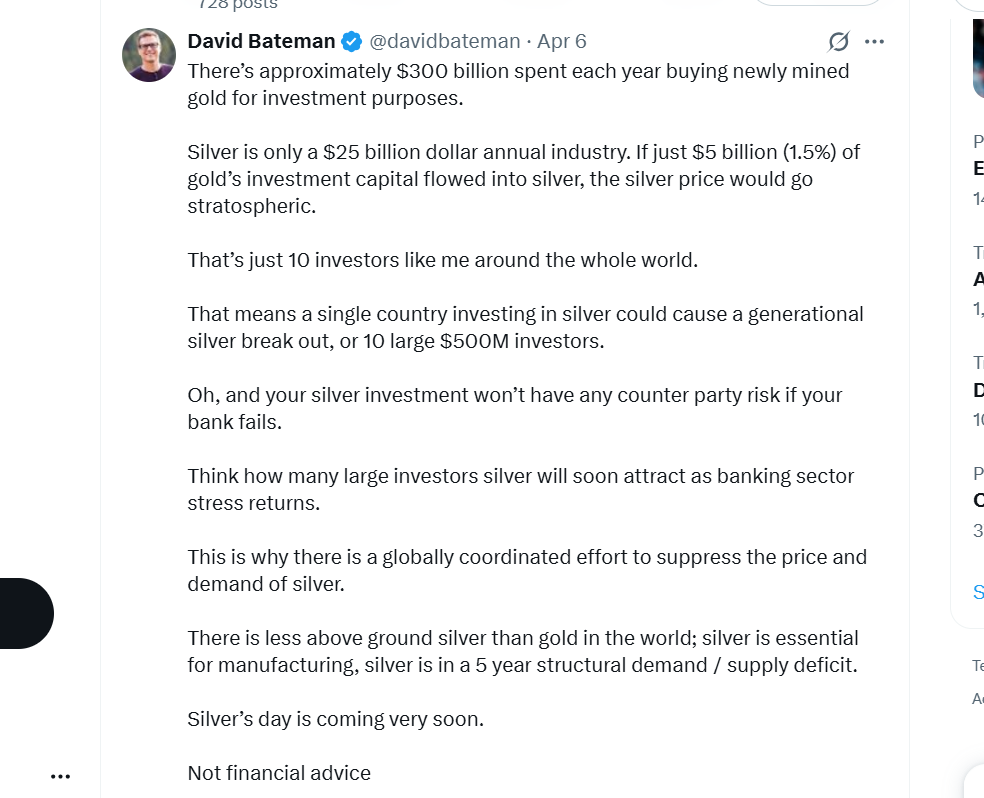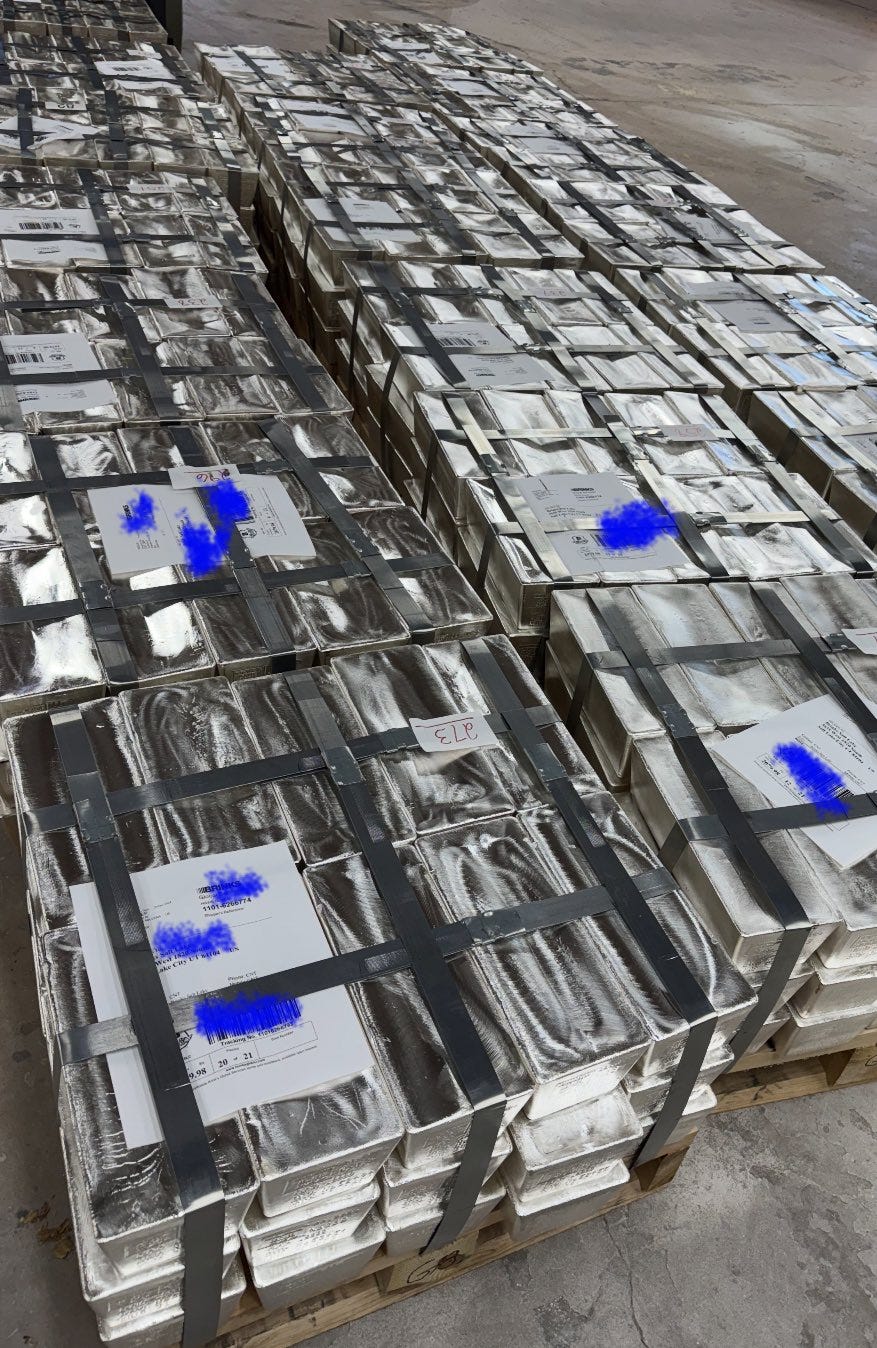If 1.5% of Gold's Investment Capital Flowed into Silver, it Would go Stratospheric
"Physical possession is everything. The whole world right now is a sophisticated game of musical chairs; the chairs are precious metals. " - David Bateman
The Silver Market’s Tug-of-War: Manipulation, Deficit, and the Looming Reckoning
The silver market is trapped in a paradox. While gold soars on central bank purchases, silver-a metal critical to solar panels, electronics, and medical devices-languishes at a historic gold-to-silver ratio of 103:1. This disparity isn’t accidental. It’s the result of a complex power struggle between industrial users, miners, investors, and bullion banks, with the latter accused of artificially suppressing prices through paper market manipulation.
The Manipulation Playbook
Bullion banks, leveraging fractional banking and central bank liquidity guarantees, flood the COMEX futures market with “paper silver”-contracts often unbacked by physical metal. This tactic exploits the law of supply and demand: a single click can dump millions of ounces into the market, driving prices down instantly. Industrial buyers then secure physical silver at depressed prices, while miners face pressure to sell at suboptimal rates. Investors, lured by low prices, often settle for paper derivatives, unaware of the structural imbalance.
Recent COMEX data reveals bullion banks have amplified their net short positions to 217 million ounces since February 2024, despite silver’s price rising from $22 to $31/oz. This counterintuitive strategy suggests desperation to offset even larger losses in London’s opaque physical market, where unbacked “cash contracts” dominate.
Winners and Losers
Industry & Bullion Banks: Profit from suppressed prices. Solar manufacturers, for instance, consumed nearly half of 2023’s industrial silver demand3, aided by artificially low costs.
Miners: While some benefit from steady sales, others lose potential revenue from undervalued metal.
Investors: Paper silver holders face systemic risk, as seen in 1980’s “Silver Thursday,” when the Hunt brothers’ failed cornering attempt triggered a 75% price crash.
China is Winning while the COMEX is Losing
The Physical Deficit Time Bomb
For four consecutive years, silver demand has outstripped supply, with 2025 projected to extend the deficit. Industrial consumption hit a record 680.5 million ounces in 2024, driven by solar expansion, military / aerospace, silver batteries and AI-related electronics. By 2027, solar alone may consume 40% of annual supply, straining reserves. Yet prices remain subdued-a disconnect that analysts attribute to paper market distortions.
The Gold-Silver Ratio: A Ticking Clock
Historically, the ratio averages 55:1, (past 5 decades) but today’s 103:1 anomaly signals silver’s deep undervaluation. Similar extremes preceded sharp reversals, like the 2011 drop to 35:1 during a commodities boom. Market mechanics suggest a correction is inevitable:
Physical Shortages: With above-ground inventories dwindling, industrial users can’t indefinitely rely on paper tricks.
Investor Awareness: Rising retail and institutional demand for physical metal-will strain manipulated markets
Regulatory Pressure: Recent convictions of JPMorgan traders for spoofing highlight growing scrutiny of bank-led manipulation.
The Hunt Brothers’ Ghost
The 1980s silver saga offers a cautionary tale. The Hunts amassed 150 million ounces, driving prices to $50/oz before collapsing under margin calls. Today, bullion banks face a mirrored risk: their massive COMEX shorts (equivalent to 25% of annual production) could trigger a short squeeze if physical shortages intensify.
The Path Ahead
While banks dominate paper trading, they can’t print physical silver. As deficits persist and green energy mandates accelerate, the industry’s structural demand may finally override financial engineering. Investors betting on a ratio correction are already accumulating physical metal and miners’ shares, anticipating a return to historical norms.
In this high-stakes standoff, the laws of economics favor scarcity over speculation. When the paper edifice crumbles, silver’s price discovery moment will arrive-and with it, a reckoning for the 100:1 ratio.
the Billionaire Betting $1B That Stackers Will Defeat the Banksters
David Bateman purchases 12.69 Million ounces of Silver and Stands for Delivery.
Who is next? Frank Giustra? Eric Sprott?
David Bateman, a billionaire tech founder, has made headlines by purchasing 12.69 million ounces of silver-about 1.5% of the world’s annual supply-alongside other precious metals, investing nearly $1 billion in total. Bateman’s massive bet is motivated by his conviction that the global financial system is on the brink of collapse, citing the $300 trillion global debt bubble, unsustainable U.S. Treasury refinancing needs, and looming monetary resets like the so-called “Basel Endgame”.
Bateman’s public announcement of his silver accumulation coincided with the “Silver Squeeze 2.0” in March 2025, amplifying market attention and sparking debate. He argues that gold and silver are the only true safe havens, emphasizing the importance of physical possession over paper or digital assets, which he views as vulnerable to systemic risk and counterparty failure. He is openly critical of cryptocurrencies (calling them a “psyop”), real estate, stocks, and bonds, predicting they will all underperform precious metals in the coming crisis.
A central theme is Bateman’s distrust of the fiat financial system and the banking sector, which he believes is engineered to seize customer assets during crises-a reference to the controversial “Great Taking” theory. He points to new Basel III regulations that increasingly penalize unallocated (paper) precious metals holdings, nudging the market toward physical delivery and potentially triggering a scramble for real metal. In this scenario, those like Bateman who already hold large physical reserves stand to benefit the most.
The article also explores the broader implications of such a large single purchase: Bateman’s accumulation puts additional stress on a silver market already strained by industrial demand and retail investor interest. The author suggests that if silver finally breaks free from years of price suppression, the upside could be dramatic-far beyond Bateman’s already-realized 20% gains.
Ultimately, the article frames Bateman as a “dark knight” figure, positioning himself as a protector of sound money amid a rigged and failing system. His actions are compared to legendary contrarian investors, and his bet is seen not just as a financial maneuver, but as a statement about the erosion of trust in traditional financial assets and institutions. The piece closes by urging readers to consider their own exposure to systemic risk and the importance of tangible, self-custodied wealth in uncertain times.
David Bateman wrote on Twitter why he purchased 12.69 Million ounces of Silver
”Here are the reasons I invested close to a billion dollars in precious metals over the past six months—including the purchase of 1.5% of the annual global silver supply (12.69 million ounces) :
The global monetary system is about to collapse (The Great Reset, or Basel Endgame). The biggest credit bubble in history will soon pop ($300T). There is no way the US can refinance its $28T in maturing treasuries in the next 4 years without an obscene amount of printing.
Trump tariffs are hastening the collapse, and it’s by design. Gold and silver are the only meaningful life raft.
Physical possession is everything. The whole world right now is a sophisticated game of musical chairs; the chairs are precious metals.
Crypto is a psyop. Those who purchase will have no chair when the music stops. Real estate, crypto, stocks and bonds will all lose significantly compared to precious metals.
The banking system has been meticulously designed to seize your assets to buoy up a collapsing banking sector (see The Great Taking).
You have ZERO counter party risk with precious metals. I’m up 20% already, on most of my purchases. This is not a drill. Your grandkids someday will either muse or lament this financial decision you’re now faced with. Don’t fail them.”
end of segment





